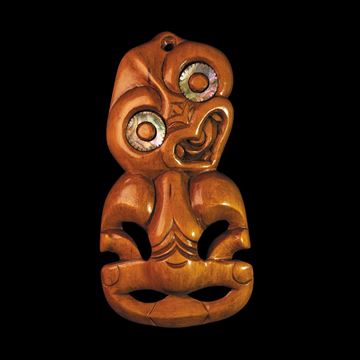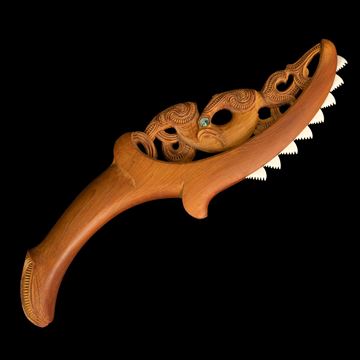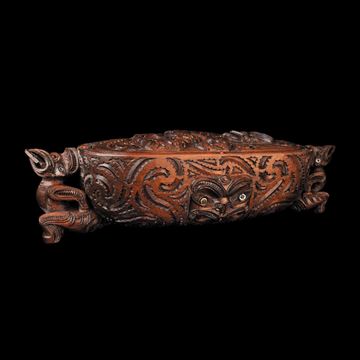
Whakairo Rākau - National Wood Carving School
Since the first intake at Te Wānanga Whakairo, many young Māori from iwi (tribes) throughout New Zealand have been taught the Māori practice of wood carving under the expert guidance of master carvers who were once trainees at the school. This tohu (qualification) is for three years and is 40 hours per week, 47 weeks of the year.
Would you like something custom made just for you? Commission a piece here
Hei Tiki - 6639CF
Hei tiki are the best known of all Māori adornments. Tiki are symbols of fertility that depict a new-born child. They are often family heirlooms bearing personal names and embodying their wearers lineage. As with most Māori personal adornments, hei tiki are often passed down generationally.
Material: Tōtara (Red Pine)
Measurements: 225mm x 115mm x 25mm
$3,900.00
Māripi - CI2895
Māripi are a traditional meat cutting tool. They are fashioned with a wooden handle and sharks’ teeth carved from Kōiwi (beef bone) to create a serrated edge.
Material: Rātā, Kōiwi (Beef Bone) & Pāua (Abalone)
Measurements: 340mm x 100mm x 30mm
$4,200.00
Māripi - CI3233
Māripi are a traditional meat cutting tool. They are fashioned with a wooden handle and sharks’ teeth carved from Kōiwi (beef bone) to create a serrated edge.
Material: Rātā, Kōiwi (Beef Bone) & Pāua (Abalone)
Measurements: 370mm x 60mm x 30mm
$3,500.00
Tekoteko - 4763TA
The tekoteko is a stylised representation of the main progenitor of a tribe and is the most focal point of the whare whakairo (carved tribal meeting house). They can be found – on traditional meeting houses – either at the highest point at the front apex of the roof or at the front central post. They can also be found at the base of the poutokomanawa (the main central ridge support post) of the house.
Material: Tōtara
Measurements: 870mm x 220mm x 180mm
$3,900.00
Tekoteko - 4813HG
The tekoteko is a stylised representation of the main progenitor of a tribe and is the most focal point of the whare whakairo (carved tribal meeting house). They can be found – on traditional meeting houses – either at the highest point at the front apex of the roof or at the front central post. They can also be found at the base of the poutokomanawa (the main central ridge support post) of the house.
Material: Tōtara
Measurements: 865mm x 210mm x 180mm
$4,200.00
Waka Tūpāpaku - CI3348
A waka tūpāpaku is a box used for containing the bones of a person of high rank after they had been exposed on the atamira platform, the flesh removed and the bones anointed with oil and red ochre, placed in a waka tūpāpaku and taken to a tribal buriel cave.
Material: Tōtara
Measurements: 580mm x 140mm x 110mm
$2,500.00
Tokotoko - 6853TH
Tokotoko are used when speaking on the marae – by esteemed orators – to indicate the direction of a speaker’s kōrero (speech). They often have the whakapapa (genealogy) of the orator carved into them and these can also be referenced by the orator during his address.
Material: Rātā
Measurements: 1050mm x 45mm x 45mm
$7,990.00
Waka Pungarehu - 2579SL
The Waka Pungarehu (Ash Urn) has two carved tekoteko (statues) positioned at the ends of the waka pungarehu which are carved in the traditional style of whakapakoko, resembling preserved corpses. The surface is intricately adorned with the raperape design, symbolizing the continuous cycle of life and the evolution of death. The pakati and haehae techniques are skillfully carved to enhance the entire waka pungarehu, with the distinctive pakati design known as niho kuri (dog’s teeth) adding a unique touch. The pakati designs feature iroiro (maggots) motifs, symbolizing the natural process of
decomposition when a human body returns to the earth.
Material: Tōtara
Measurements: 450mm x 110mm x 90mm
$10,500.00
Pūtōrino (on Stand) - 4799KA
In Māori whakapapa (genealogy), all Māori flutes come to us from Hine Raukatauri, the daughter of Tānemahuta, the atua (spiritual entity) of the forest and birds. Hine Raukatauri is best known as the atua of flute music. She loved her flute so much that she chose to live inside it. She is now personified as the case moth that hangs from branches of trees in a long slender cocoon. This case moth cocoon is where the pūtōrino gets its shape from.
Material: Mataī (NZ Native)
Measurements: 400mm x 70mm x 50mm
$7,990.00
Wakahuia - 4783KA
Customarily wakahuia were vessels used for housing valuable feathers of the revered native huia bird. Following the extinction of the huia, wakahuia are now more commonly used to retain the treasured heirlooms of its owner such as hei tiki and other adornments. Wakahuia were originally designed to be suspended from the rafters of a dwelling and therefore had as much carving on the lower surface as the top. Wakahuia were highly prized and carefully treasured as they were passed between generations as heirlooms. They were often gifted between whānau, hapū and individuals to acknowledge relationships, friendships, and other significant social events.
Material: Tōtara
Measurements: 345mm x 110mm x 90mm
$9,500.00
Kōauau 4439HY
Kōauau are part of the flute family and come to us from the atua (spiritual entity) of flute music Hine Raukatauri. Kōauau is also the name for a species of hollow kelp, which can also be used to make instruments. Kōauau are made from a variety of different materials including wood, bone or sometimes stone. Most kōauau have three wenewene (finger holes) although there are several older examples that have four or more. The kaiwhakangāwari is the wenewene closest to the mouth, the kaiwhakahī is the middle wenewene and the kaiwhakakaha is the wenewene closest to the distal end.
There are many uses for kōauau. In Māori tradition, birds are sometimes seen as important messengers from the spirit world. Kōauau have a reputation of attracting the native birds of Aotearoa. The birds will often interact with the beautiful melody from the kōauau, giving us a glimpse of the spiritual aspects of the kōauau song.
Material: Mataī (NZ Native)
Measurements: 123mm x 26mm x 26mm
$850.00
Kōauau 5859HY
Kōauau are part of the flute family and come to us from the atua (spiritual entity) of flute music Hine Raukatauri. Kōauau is also the name for a species of hollow kelp, which can also be used to make instruments. Kōauau are made from a variety of different materials including wood, bone or sometimes stone. Most Kōauau have 3 wenewene (finger holes) although there are several older examples that have 4 or more. The kaiwhakangāwari is the wenewene closest to the mouth, the kaiwhakahī is the middle wenewene and the kaiwhakakaha is the wenewene closest to the distal end.
There are many uses for kōauau. In Māori tradition, birds are sometimes seen as important messengers from the spirit world. Kōauau have a reputation of attracting the native birds of Aotearoa. The birds will often interact with the beautiful melody from the kōauau, giving us a glimpse of the spiritual aspects of the kōauau song.
Material: Mataī (NZ Native)
Measurements: 123mm x 26mm x 26mm
$850.00
- 1
- 2












